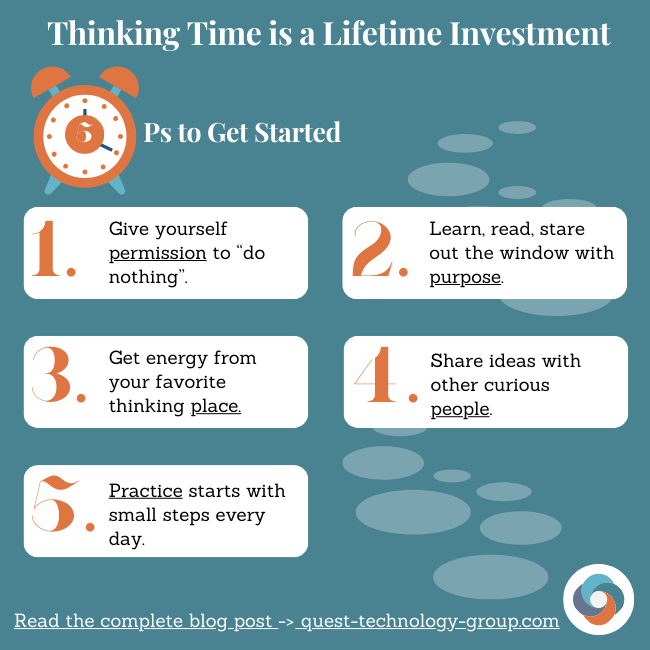Successful People Like Elon Musk and Warren Buffett Practice Thinking Time Rule

“Five percent of the people think;
ten percent of the people think they think;
and the other eighty-five percent would rather die than think.”
― Thomas A. Edison
I remember as a child hearing my mother mutter loudly and often, "I can't even hear myself think." I thought that was funny even though it didn't make any sense. Even a 6-year-old knew that whatever was in her mother's head wasn't going to magically fly out so she could hear it.
Of course, being unable to hear yourself think isn't an actual hearing problem. Our heads are simply too full of an endless stream of information, noise, and demands competing for our attention. And yet, somehow, we're supposed to be more productive now than ever. The pressure to do more feels relentless.
There's a Solution to the Pressure of Endless Productivity
Are you wondering why you would invest the few spare minutes you have left in your typical day to just sit, stare out the window, and think? You're not alone.
But here's what changed my mind about thinking time. I love learning what successful people do that seems to put them at the top of their game consistently. What do they know that the rest of us don't? What I found is there's a common thread among many of them.
In spite of their incredible daily demands, they make time to think. Not just random thoughts ---but seriously focused thinking time.
How can the rest of us learn from these leaders and carve out time in our already overcrowded day? Let's call it the Thinking Time Rule.
During Bill Gates’ active Microsoft years he went away for two weeks each year to read and think. If he could give himself that gift of solitary time, then maybe there was something to this thinking time idea.
Adopting your personal Thinking Time Rule is absolutely doable. You can start right now with these five mind shifts.
1. Give yourself permission to think
“Thinking is the hardest work there is, which is probably the reason so few engage in it.”
--- Henry Ford
From the time we were young, we were encouraged to "do something", to "pay attention." Staring out the window was the mark of a shiftless daydreamer. Elon Musk said he would simply stare out the window for hours when he was a child. It was then he saw his vision for space travel.
Even the act of data gathering needs thinking time to turn raw data into useful information. Measuring without thinking is a job half done.
2. Give your thinking time purpose
“I insist on a lot of time being spent, almost every day, to just sit and think. That is very uncommon in American business. I read and think. So I do more reading and thinking, and make less impulse decisions than most people in business. I do it because I like this kind of life.”
--- Warren Buffett
The important thing to remember is that all reading and learning are not equal. The content must be truthful, factual, and inspire further thought. Social media doomscrolling doesn't count.
In How to Think by Alan Jacobs, Jacobs tells the story of Jason Fried, the creator of the project management software Basecamp. Fried was attending a conference talk and didn’t like the talk. He didn’t agree with the speaker’s point of view and become more irritated as the talk continued. When it was over, he rushed up to the speaker to express his disagreement.
The speaker patiently listened and then said “Give it five minutes” Fried was taken aback, and then he had his aha moment. After just the first few minutes of the speaker’s lecture, Fried had effectively stopped listening. He had heard something he didn’t agree with and immediately entered Refutation Mode. In Refutation Mode there is no listening.
When there is no listening there is no thinking. To enter Refutation Mode is to say that you’ve done all the thinking you need to do. No further information is required or received. Fried was so inspired by the speaker’s simple request that he adopted“ give it five minutes ” as a kind of personal thinking guidepost.
3. Find your thinking place
“All truly great thoughts are conceived while walking.”
--- Frederich Neitzsche
Thinking happens in your head. It receives the energy it needs from the surroundings that are uniquely yours.
Theodor Geisel, known to most of us as Dr. Seuss, spent his workdays in a secluded bell tower outside his La Jolla, CA house. The walls covered with drawing and pictures created the inspiration he needed to feed his imagination.
Thinking doesn’t need to happen in isolation. Often mental and physical wandering connects the dots in surprising new ways.
Steve Jobs famously roamed the small kitchen appliance aisles of Macy’s one day. It was there that his iconic Mac design was inspired.
Howard Schultz roamed Italy visiting coffee bars.
There is no right or wrong place to think. You might start by going to the place where you always slow down and breathe. It might be your favorite corner coffee shop, bookstore or peaceful park. The choice is yours.
4. Share your thoughts and ideas with curious people who inspire you
“When I get ready to talk to people, I spend two thirds of the time thinking what they want to hear and one third thinking about what I want to say.”
--- Abraham Lincoln
Sharing your ideas with other curious thinkers broadens your mind. You will see new connections in surprising ways. As refreshing as reflective thinking is, too much time in your own head can narrow your perspective and limit your thinking.
I’ve learned when I have had enough in-my-head time and need the company of others.
As Stephen King said, “The thought process can never be complete without articulation.”
Intuit founder Scott Cook watched his wife’s ongoing frustration with managing their finances. When he had a sneak peak at the Apple Lisa before its launch, he immediately connected the user interface of the Lisa with his wife’s recordkeeping. Thoughtfully connecting these unrelated dots led to the creation of Intuit and an immediate 50% market share success.
Warren Buffett and his longtime friend and business partner Charlie Munger both are avid readers, learners and thinkers. But reading alone won’t take you far enough. It’s being able to process, think, and share what you learn that makes all the difference.
Charlie Munger once said “Neither Warren nor I is smart enough to make the decisions with no time to think. We make actual decisions very rapidly, but that's because we've spent so much time preparing ourselves by quietly sitting and reading and thinking."
5. Thinking takes practice
“Simple can be harder than complex: You have to work hard to get your thinking clean to make it simple. But it’s worth it in the end because once you get there, you can move mountains.”
― Steve Jobs
The Thinking Time Rule gives you the permission to craft your own unique thinking ritual. When and where aren't nearly as important as your commitment to think every day. Start by finding those wasted minutes in your day. What do you want to accomplish when you can hear yourself think?
Jeff Weiner schedules two hours of thinking time daily. You might not have the luxury of two hours, but you do have 30 minutes somewhere.
Warren Buffett told this story in an interview for his biography The Snowball:
“Charlie, as a very young lawyer, was probably getting $20 an hour. He thought to himself, 'Who's my most valuable client?' And he decided it was himself. So he decided to sell himself an hour each day. He did it early in the morning, working on these construction projects and real estate deals. Everybody should do this, be the client, and then work for other people, too, and sell yourself an hour a day.”
The Takeaway: Adopt the Thinking Time Rule
The next time you can’t hear yourself think or simply feel the urge to wander, just do it. Give yourself permission to welcome the thoughts rolling around in your head.
Thinking time is a habit practiced regularly by successful, fulfilled people.

Discover Practical Knowledge Sharing for Business & Technology Leaders
If you've ever searched for a place to connect with business leaders without the ads, sales pitches, and usual social media clutter, you know how hard that can be.

That's why we created Studio CXO. We're business leaders like you who know there can be a better way.
Explore Studio CXO Now
 Linda Rolf is a lifelong curious learner who believes a knowledge-first approach builds valuable client relationships. She is fueled by discovering the unexpected connections among technology, data, information, people and process. For more than four decades, Linda and Quest Technology Group have been their clients' trusted advisor and strategic partner.
Linda Rolf is a lifelong curious learner who believes a knowledge-first approach builds valuable client relationships. She is fueled by discovering the unexpected connections among technology, data, information, people and process. For more than four decades, Linda and Quest Technology Group have been their clients' trusted advisor and strategic partner. Linda believes that lasting value and trust are created through continuously listening, sharing knowledge freely, and delivering more than their clients even know they need. As the CIO of their first startup client said, "The value that Quest brings to Cotton States is far greater than the software they develop."
